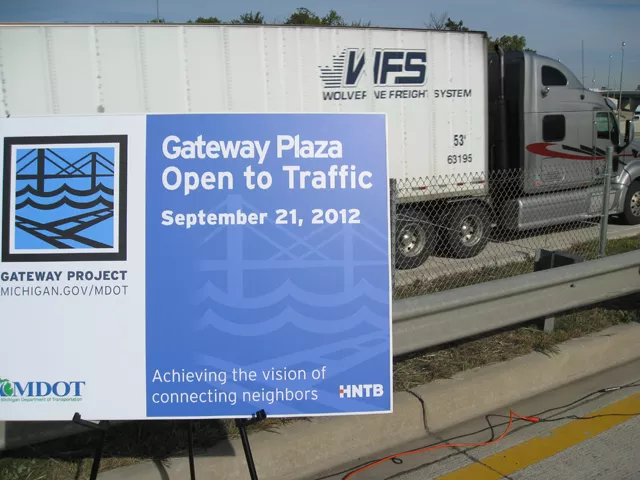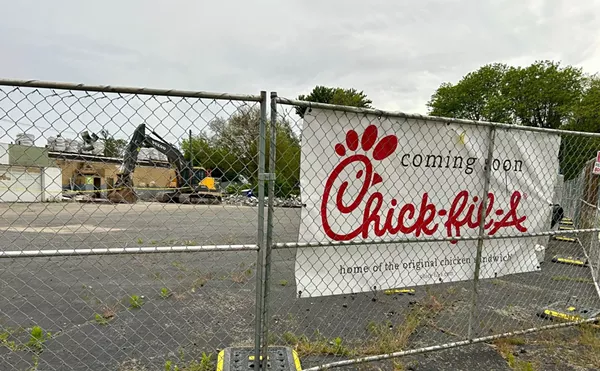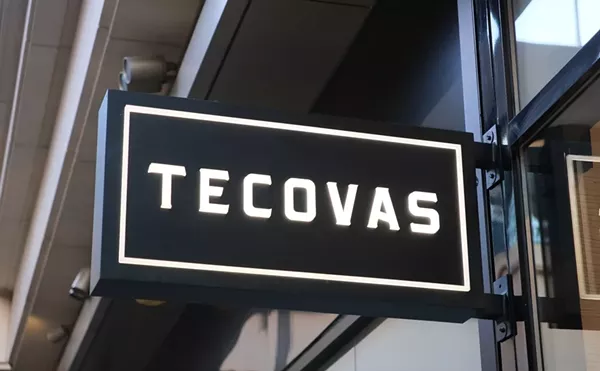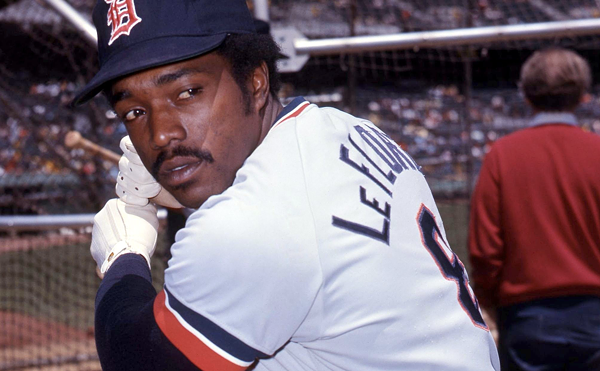
Audio By Carbonatix
[
{
"name": "GPT - Leaderboard - Inline - Content",
"component": "35519556",
"insertPoint": "5th",
"startingPoint": "3",
"requiredCountToDisplay": "3",
"maxInsertions": 100,
"adList": [
{
"adPreset": "LeaderboardInline"
}
]
}
]

In terms of news value, ribbon-cutting and groundbreaking ceremonies typically don't offer the kind of raw, red meat we here at the Hits prefer chewing on. Which is why we usually avoid events that involve guys in suits donning reflective vests and hard hats.
But last Friday was a little bit different. We wanted to experience the satisfaction of seeing an exclamation point added to a story we've been deeply immersed in for the past few years.
So, we grabbed a camera and headed over to the I-75 service road just off West Grand Boulevard in southwest Detroit to witness the official opening of the long-delayed Gateway project.
As we stood there, watching big rigs roll past on the interstate, with some of the truckers gleefully blasting their air horns, the predominant thought was: This should have been happening at least four ago.
There is, of course, a very good reason the public-private project intended to ease the flow of traffic onto the Ambassador Bridge and get semis off local surface streets experienced the unconscionable, completely unnecessary delay: Manuel "Matty" Moroun and the Detroit International Bridge Co. that he and his family own.
That delay, along with the scurrilous conduct of Matty and his minions throughout this long and costly ordeal — which caused a lot of very real hardship — speaks volumes about the (completely shady) character of the people banking on the hope a majority of Michigan voters will be gullible enough to buy their lies come November.
First, a little history.
Back in the mid-1990s, the Michigan Department of Transportation began looking at ways to reconfigure Interstates 75 and 96 near the privately owned Ambassador Bridge so that traffic could flow more freely, and the people living in southwest Detroit wouldn't have to put up with the noise, fumes and congestion caused by the relentless stream of semi trucks rolling through their neighborhoods.
Finally, after much study and consideration, MDOT in 2004 entered into a contract with the Detroit International Bridge Co. (DIBC), the Moroun family business that owns the Ambassador Bridge.
The state, with the aid of federal funds, would spend $230 million improving the flow of traffic on and off the bridge; the DIBC would be responsible for doing some specified work on the massive truck plaza, with its fuel pumps and duty-free shop, adjacent to the bridge.
While the state began its share of the work, the DIBC set off on a new course, ignoring the contract as it set about doing work that was entirely in its interest while screwing everyone else.
Most prominent in all this was the now-infamous "ramp to nowhere" — an approach to a hoped-for new bridge the company said it intended to build, even though the project had not (and still has not) received approval from government officials in America or Canada.
The problem is that ramp, referred to in a library's worth of court documents as Pier 19, stood in the way of one of the planned roadways intended to remove bridge truck traffic from neighborhood streets.
In November 2009, more than a year after the project was supposed have been wrapped up, the state sued, claiming the company was in breach of contract and asking Wayne County Circuit Court Judge Prentis Edwards to order Matty and his crew to tear down what wasn't supposed to be there, and to complete their share of the project as outlined in the contract.
In early 2010, Edwards, after patiently listening to all the company's experts and arguments, ruled in favor of the state and told the company to get the job done, and to do it the way it was designed.
The company, staying true to its history, continued to litigate. At one point, it attempted to have the case moved to federal court. The result?
"Considering this Court's more than 33 years as a judicial officer, DIBC may be entitled to its recognition as the party who has devised the most creative schemes and maneuvers to delay compliance with a court order," U.S. District Judge Patrick Duggan declared.
In early 2011, frustrated by the company's stubborn refusal to build its share of the project as planned, and oppoed to unilateral changes being made to key aspects of the design (including illegally closing off a city street), the state sought to have the company found in contempt.
More court action ensued. Mostly, the company kept making the same argument over and over — that there was never really an agreed-upon plan for it to follow.
Edwards, fed up with the steady supply of manure the company's lawyers kept trying to feed him and dismayed by a blatant disregard of lawful court orders, found the DIBC in contempt and sent its president, Dan Stamper, to jail for a few hours, just so the message would be delivered that this was serious.
Upon Stamper's release, the company pledged that it would change its ways and abide by Edwards' rulings. But it did neither; instead, it only continued to stall progress.
And so, early this year, company officials — including Matty, an octogenarian billionaire — were again cited for contempt. This time, Edwards threw both Matty and Stamper into the slammer, where they spent the night.
At one point, hitting a new low even for them, lawyers for the company filed court documents that essentially accused Edwards and a court-appointed monitor of conspiring with the governor's office in an attempt to strong-arm the bridge company into giving up its opposition to a new publicly owned bridge a few miles downriver.
Lawyers for the company claimed that they were told in a secret meeting that Edwards would continue to rule against the DIBC as long as it kept trying to prevent the new bridge from being built.
There's never been a shred of any real evidence that claim besmirching the character and ethics of Edwards had any basis in reality.
It was, rather, just one more example of a company willing to say and do anything in order to get what it wants. (You may recall that this is the same company that spent years in court trying to keep control of a piece of public parkland it had absolutely no right to.)
But the sleazeball tactics didn't work. Instead of succumbing to the DIBC slime-hurling, Edwards removed the company from the project completely, ordering it to cough up $16 million and putting the work in the hands of MDOT to complete.
The result was that, in just over six months, Pier 19 was removed, the work was completed as originally designed, and the suits were putting on hard hats and vests to attend last week's ceremony.
As far as we can tell, the company's appeals have all been exhausted. No higher court bought the feeble contention that Edwards had made any improper rulings.
In fact, the only court action that remains is one brought by the state, which is claiming that the company owes the state in excess of $1 million, according to an MDOT spokesman.
So, other than the joy felt by the residents of southwest Detroit and truckers alike now that Gateway is finally done, why is any of this all that pertinent?
Because the same folks who wasted much time and money trying to defend an indefensible position in court are now attempting to convince Michigan voters that the DIBC and its owners are trying to protect hard-working citizens from the perfidy of the governor and state bureaucrats.
Gov. Rick Snyder fully supports construction of what's being called the New International Trade Crossing. Because the DIBC's lobbying and campaign contributions succeeded in having the effort languish in the Legislature, Snyder found a way to move the project ahead on his own.
The DIBC responded by placing on the ballot Proposal 6, a measure that seeks to amend the state constitution so that any international bridge or tunnel project must clear the hurdle of a statewide vote before being constructed.
Having succeeded in collecting the signatures necessary to get "The People Should Decide" on the November ballot, the company is spending millions to convince people that they should vote for it.
The seemingly omnipresent commercials urging a "yes" vote never mention that the DIBC and its owners are desperate to fend off competition to the near-monopoly they enjoy, generating an estimated $60 million a year in revenue as a result. Instead, they keep claiming that the proposed ballot measure is an attempt to protect hard-working taxpayers from getting screwed.
Central to this argument is the claim that, contrary to the position of just about everyone not connected to the DIBC, Canada won't really be paying all construction costs for the new span and then recouping the money from tolls in years to come. Instead, say the owners of the Ambassador Bridge, Michigan taxpayers are secretly being put on the hook.
To the surprise of absolutely no one at all familiar with how the DIBC and the Morouns do business, an independent watchdog has repeatedly declared that the Prop. 6 campaign is built on a foundation of lies.
Just last week, the "referees" at the nonprofit, nonpartisan Michigan Truth Squad flagged the proponents of what's officially known as Proposal 6 with another "flagrant foul."
This is what the watchdogs have to say:
"The battle over a second bridge is about money — the Moroun family's money. ... There is a reason that the family interests have spent millions in campaign contributions, lobbying efforts and TV ads in recent years to stop the NITC [New International Trade Crossing] project — not to mention what sums have been spent by Moroun interests in legal challenges to the project.
"Michigan voters may want to ask themselves one question: Why are Moroun family interests spending millions to 'protect' the average taxpayer?"
Excellent question.
Here's the bottom line, according to the Truth Squad, about the campaign being waged by the Morouns, who are trying to convince you that a new bridge will result in the firings of teachers, police officers and firefighters as a cash-strapped state struggles to pay for a bridge that will create a massive debt burden for future generations:
"These ads repeat claims, or advance new variants of old claims, that do not match available documents. The agreement with Canada puts the financial onus on Michigan's neighbor, not Michigan, for paying the bills, including interest. Since Michigan is not appropriating construction dollars, no dollars are being diverted away from other public uses. Michigan is not increasing its debt load with the NITC project."
This is where the grand opening of the Gateway Project and the campaign for Prop. 6 merge:
The Moroun family and the DIBC spent years delaying completion of a much-needed project that will benefit many because they were trying to further their own narrow self-interests.
Now, having lost that battle, they are pulling out all the stops in an attempt to deceive voters across the state, trying to con them into believing that the DIBC and the Moroun clan really care about the people of Michigan.
The lesson to be learned from the court battle over Gateway is this:
The bridge company and its owners will do and say just about anything to get their way.
And they cannot be trusted to look out for the public's interest.
Ever.
News Hits is written by Curt Guyette. Contact the column at 313-202-8004 or NewsHits@metrotimes.com.





